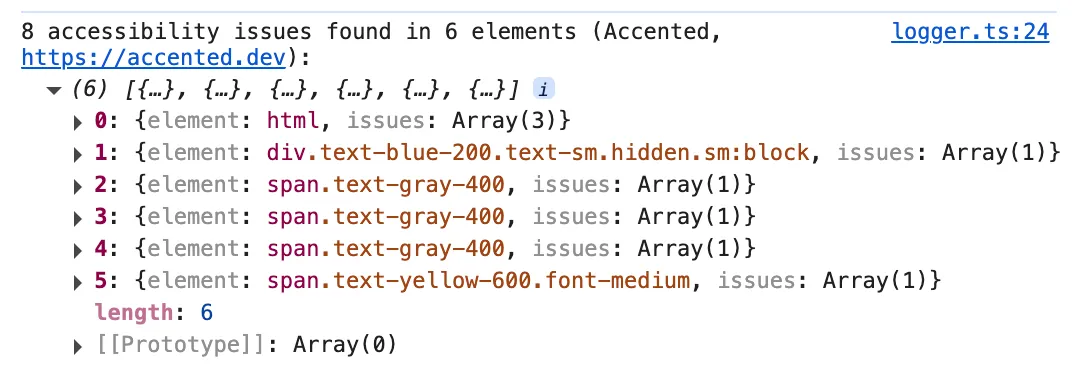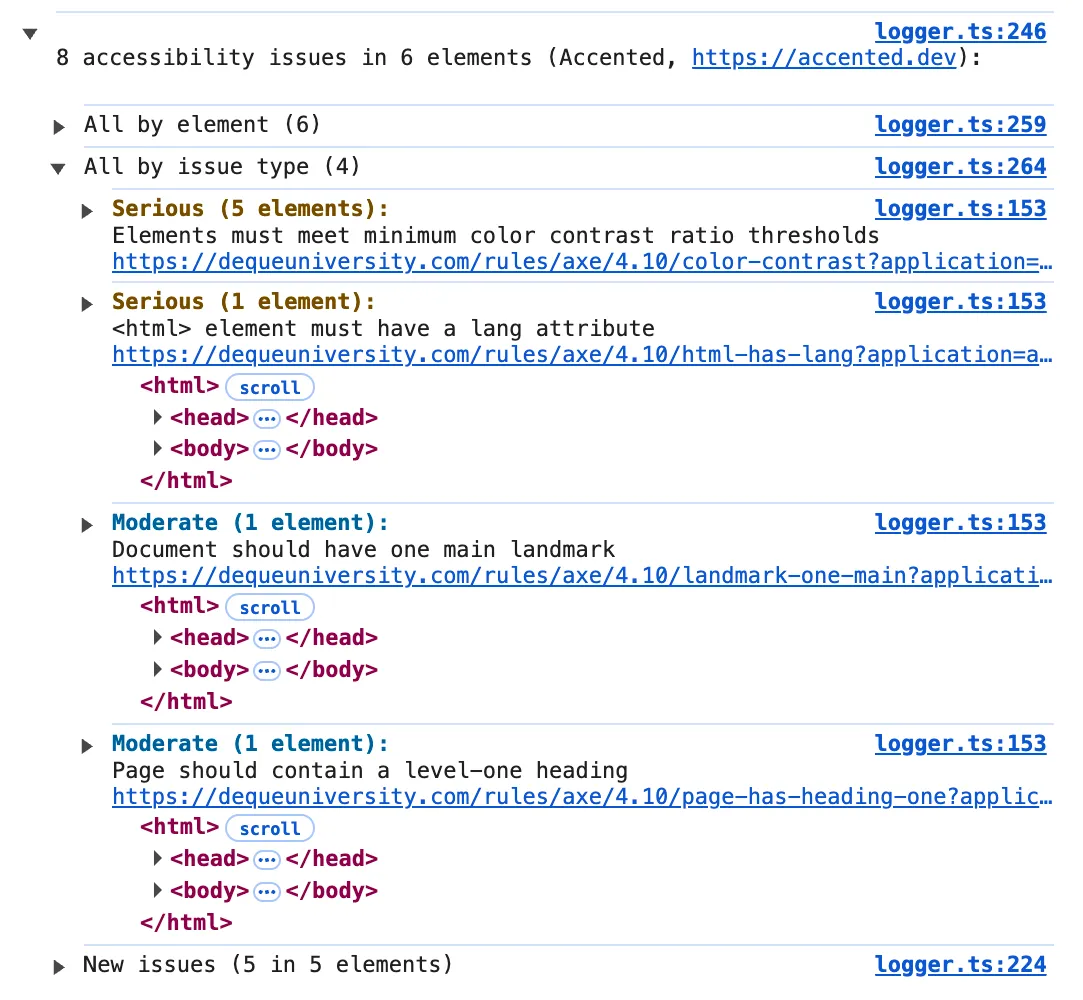Accented: a modern alternative to @axe-core/react
Accented now includes a console-only mode. It does what @axe-core/react does — without being limited to legacy React apps.
@axe-core/react is a fairly popular accessibility testing package (based on its NPM download numbers). I wasn’t aware of it when I started working on Accented, but Dylan Barrell (the original author of axe-core) brought it up when we met at the A11y NYC meetup a few months ago.
The basic premise of both libraries is the same: on any DOM change, run the Axe script and output whatever issues it finds.
Their APIs are also very similar.
Accented:
if (process.env.NODE_ENV === 'development') {
const { accented } = await import('accented');
accented();
}@axe-core/react (we have to pass the instances of React and ReactDOM — more on that below):
if (process.env.NODE_ENV === 'development') {
const { default: axe } = await import('@axe-core/react');
axe(React, ReactDOM);
}There’s one key difference in how I envisioned Accented.
@axe-core/react only logs results in the console, while Accented’s primary focus is on highlighting problematic elements directly on the page.

It’s easy for a developer to disregard console output: as a project grows, the console often becomes cluttered with messages, making it harder to distinguish signal from noise. The developer may also not even be looking at the console.
On the other hand, it’s much harder to ignore a thick, bright outline around an element on the page. Which helps with the primary goal of both Accented and @axe-core/react, namely to make the developer notice an issue as soon as they introduce it.
A console-only mode in Accented
With that said, console warnings are still better than nothing when it comes to notifying of accessibility issues, especially if you don’t want a third-party library to change your DOM. And Accented by default certainly does affect the DOM, even if it tries to keep modifications to a minimum.
So in version 1.1.0, I introduced a way to only output console messages without altering the page at all.
accented({
output: { page: false }
});Inspired by @axe-core/react, I also overhauled Accented’s console output, making it a lot more polished and user-friendly.
Before (just a plain JavaScript object):

After (the issues are color-coded, and the information is grouped and easier to navigate):

Migrating from @axe-core/react to Accented
If you’re using @axe-core/react today, switching to Accented should be straightforward.
See First steps for instructions on how to install and import Accented.
Note: Accented is distributed only as an ES module. You may need to update your build configuration if your app uses CommonJS.
Basic usage
// @axe-core/react
// The third argument (delay) is optional,
// but setting it is generally recommended.
axe(React, ReactDOM, 1000);
// Accented
// (a 1000-millisecond throttling delay is enabled by default).
accented({
output: { page: false }
});Debouncing / throttling
Both libraries let you control the delay (in milliseconds) between a DOM update and a scan:
- @axe-core/react: Debouncing.
- Accented: throttle.
@axe-core/react uses debouncing, while Accented relies on throttling (see difference between throttling and debouncing), though in practice, the UX difference is minimal.
Here’s how to set a 2000-millisecond delay:
// @axe-core/react
axe(React, ReactDOM, 2000);
// Accented
accented({
output: { page: false },
throttle: {
delay: 2000,
leading: false
}
});Disabling rules
// @axe-core/react uses the `rules` format from `axe.configure`:
// https://www.deque.com/axe/core-documentation/api-documentation/#api-name-axeconfigure
axe(React, ReactDOM, 1000, {
rules: [
{ id: 'heading-order', enabled: false },
{ id: 'color-contrast', enabled: false }
]
});
// Accented uses the `rules` format from `axe.run`:
// https://www.deque.com/axe/core-documentation/api-documentation/#options-parameter
accented({
output: { page: false },
axeOptions: {
rules: {
'heading-order': { enabled: false },
'color-contrast': { enabled: false }
}
}
})Context
Like @axe-core/react, Accented lets you define which elements should be included or excluded from scanning.
Note: Accented doesn’t support scanning iframe contents from the parent document,
so the fromFrames shape
of the context object isn’t supported.
// @axe-core/react:
axe(React, ReactDOM, 1000, undefined, {
exclude: '.do-not-scan-me'
});
// Accented:
accented({
output: { page: false },
context: {
exclude: '.do-not-scan-me'
}
});Output deduplication
@axe-core/react has a disableDeduplicate option,
which controls whether it prints all issues on each DOM change, or only the new ones.
Accented doesn’t offer an equivalent option. Instead, it logs all issues and new issues separately with every DOM update, so the developers can easily find whatever issue or element they’re searching for.
Looking forward
I see Accented as a modern alternative (and in a way, a spiritual successor) to @axe-core/react.
The latter has been a valuable tool for many developers, but it has its limitations.
It relies on certain React internals,
which is why we need to pass the React instance to the @axe-core/react initializer.
It doesn’t work with modern React versions
or the newer JSX runtime.
And it’s entirely incompatible with non-React projects.
Accented doesn’t have any framework dependencies, so it’s not subject to those constraints. It uses a mutation observer to detect changes in the DOM and trigger accessibility scans.
In most cases, Accented can now serve as a true replacement for @axe-core/react (compare Accented API and @axe-core/react API). But my hope is that it will be used more broadly, beyond legacy React versions, beyond React, and beyond the console.